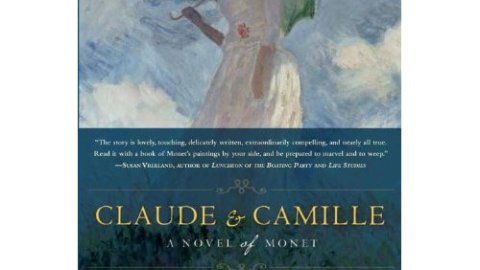Novel Lives: Stephanie Cowell’s Claude and Camille: A Novel of Monet

The Impressionists now stand as the ultimate in artistic comfort food for the mainstream public. The billowy softness of their images graces office walls in framed reproductions and countless calendars. Of all the Impressionists, perhaps none recalls warm mashed potatoes as much as Claude Monet. In contrast to the thundering tempest of Vincent Van Gogh’s well-publicized life, Monet’s existence, or what little the general public knows of it, breezes easily past, like the gentle clouds that populate his landscapes’ skies. Stephanie Cowell’s Claude and Camille: A Novel of Monet injects blood and breathes new life into Monet and allows us to see him and his contemporaries as the radical experimenters they were (and were derided for being).
Cowell runs a blog titled “The Everyday Lives of the French Impressionists” that gives a daily dose of these artists’ lives. Claude and Camille gathers together many of those stories and more into a beautiful and inspiring narrative of a man finding himself as an individual as well as an artist. Cowell’s passion for the telling anecdote allows her to enter imaginatively into the life of Monet and put us not only beside him as he struggled to establish himself in the art world, but also as he struggled inside his own head to balance his passion for art with his passion for his beloved Camille, who abandoned a life of privilege to walk beside him in penury.
The cult of Van Gogh begun with Irving Stone’s Lust for Life mars many fictional treatments of artists’ lives. Unless someone’s going mad in the name of art, the story seems unworthy of being told. This subsection of the modern cult of personality simultaneously places the artist on a pedestal and lifts him beyond our reach. Claude and Camille allows us to hold hands with Monet as he struggles with the same everyday forces beyond our control that we face today. The idea of a Monet who combats family expectations at one juncture of his life and literally faces combat in the theater of war at another juncture doesn’t diminish him as an artist; rather, it elevates him as a human being.
With colorful period detail and deft emotional insight, Cowell recreates the life of Monet and his world that adds an entirely fresh dimension to the paintings that long-time exposure has left us too comfortable in viewing. Monet and the Impressionists challenged humanity to see the world differently. The magnitude of their success dulls the edge they once wielded to razor through prior artistic preferences. Cowell sharpens Monet’s life and cuts through our comfort level to reveal the radical beneath.
Claude and Camille, however, remains at its heart a love story. Cowell juxtaposes tales of bold and youthful struggle with interludes of repose in old age. Recalling the past while living alone years later among the gardens of Giverny, Monet muses:
“There she stood in his first portrait of her, when she was just nineteen, wearing the green promenade dress with the long train behind her, looking over her shoulder, beautiful, disdainful, as she had appeared nearly half a century before. He rose and lightly touched the canvas. Sometimes he dreamt he held her; that he would turn in bed and she would be there. But she was gone, and he was old. Nearly seventy. Only cool paint met his fingers. ‘Ma très chère . . .’”
For anyone wanting to know more of the “real” Monet, and not the neutered, homogenized, over-calendarized version, Claude and Camille will inspire you with its humanity and insight. For anyone wanting a simple love story, Claude and Camille will deliver as well. For anyone seeking both, Claude and Camille will make you rethink what you thought you knew about art, life, and love.
[Many thanks to Random House for providing me with a review copy of Stephanie Cowell’s Claude and Camille: A Novel of Monet.]





